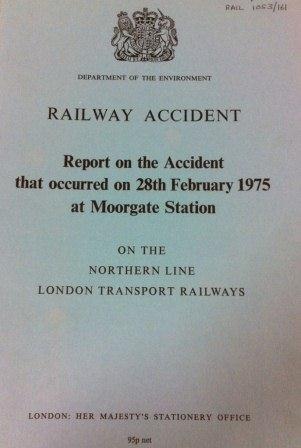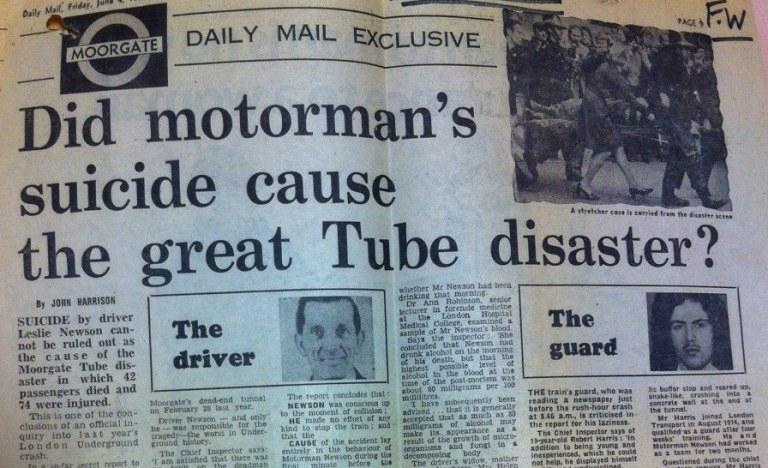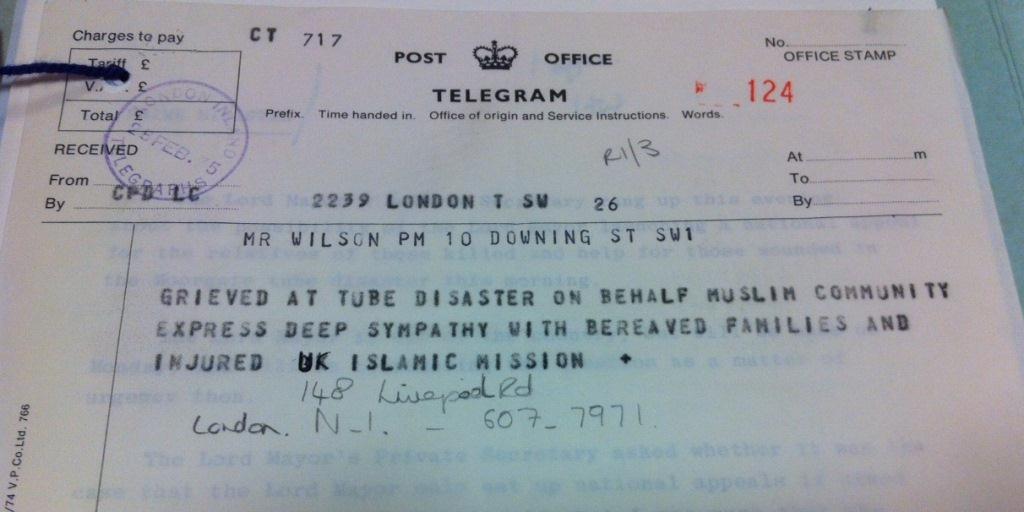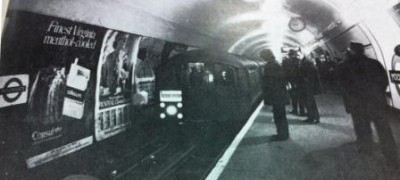
Report cover, catalogue reference: RAIL 1053/161/5.
28 February 2015 is the 40th anniversary of the Moorgate Tube crash in 1975. Files from various government departments held here at The National Archives provide more information on this crash, the worst ever on the London Underground, which tragically resulted in 43 deaths and 74 people hospitalised with injuries.
The accident occurred when Northern Line train number 272, carrying 300 passengers, overran the Underground station at Moorgate, ploughing into the sand-drag (intended to slow trains which had failed to stop), hitting the buffer-stop and crashing into the concrete wall at the end of the tunnel.
The recommended speed on approaching the station was 15 miles per hour, but on this occasion the train was travelling at over 35 mph and appeared to be accelerating. When rescuers first reached the platform it appeared to them that a four coach train had stopped at the station. Then it dawned on them that the first two and half coaches had crumpled to half their length in the remainder of the tunnel. The first coach had creased itself up into the roof of the tunnel with the second coach driving under the back of it. The third coach had risen up over the second, impacting on the first coach.
A Lord Chancellor’s Department file, LCO 20/1102, dealing with compensation for personal injury cases includes information on the size of the recovery. The six day rescue operation involved 1324 firemen, 240 policemen, 80 ambulance men, 16 doctors and numerous voluntary workers and helpers. The last body to be brought out of the tunnel was that of the driver, Leslie Newson, a 56 year old husband and father of two children.
Mystery has surrounded the cause of the accident, and to this day no-one has been able to explain why it happened. The Official Department of the Environment Report on the accident (RAIL 1053/161/5) reveals that the train was old, dating from 1938, but it and the braking system were all in good working order.
The report includes statements from work colleagues who say that the driver, Leslie Newson, was known to be naturally cautious in his driving habits. A quiet man with few friends, he always wore his uniform in full and rarely drank alcohol. His usual practise when approaching stations was to slow down early and let the train coast into position at the platform.
A post mortem showed that he had not had a heart attack, nor had he suffered an epileptic fit. The previous day he had asked his wife to withdraw some money with which he planned to buy his daughter a car – not the actions of someone intent on suicide, although the press made the point that he had not even raised his hands to protect his face when the crash occurred. The guard on the train stated that Newson had ominously overshot at another station the previous week.

Newspaper report, catalogue reference: AN 183/15.
Following the disaster London Transport introduced a permanent 10mph speed limit on all trains entering ‘dead end’ passenger locations, as referenced in the British Railways Board Operations file AN 183/15. In 1978 a system called ‘Moorgate Protection’ was introduced, which automatically applied the brakes if the driver had failed to do so.
News of the crash spread around the world, and Prime Minister’s Office file PREM 16/332 shows that telegrams of condolence were received by the Prime Minister, Harold Wilson, from such diverse countries as Lesotho, New Zealand, The Socialist Republic of Romania and the Republic of Zambia. He also received a telegram from the UK Islamic Mission, and a Memorial Service was held at St. Paul’s Cathedral on 19 March 1975, at which nearly 2000 people attended.

Telegram from the UK Islamic Mission, catalogue reference: PREM 16/332.
Despite all the investigation, the eye-witness evidence and the various theories, no conclusive reason has ever been given for the cause of the crash, except ‘driver error’. Was Newson suicidal, was he taken ill or was he simply distracted by something? Nobody will ever know what the driver of train 272 was thinking as he drove into Moorgate Station at 8.46 that terrible morning.

Moorgate Station (RAIL 1053/161/5).
Unfortunately I was on this train to Moorgate and was only 19 years old.
I remembered being in the second carriage , I am still haunted by the desperate cries of the the people trapped in other carriage.
I was made to understand that, a young police woman in the carriage with me had to have her ankle
Amputated in order to save her.
I still find it so hard to travel on the tube.
My mother was also on the train-in the same carriage as yourself I believe. She was slightly older than you (23 at the time)-she rarely speaks of the crash, and has only recently been able to travel on the underground-I know she finds it hard still.
Hi. My Aunty Janet cook age 17 at the time died on that train. My dad finds it so hard to get on trains and it had driven my grandad mad, and my nan died very young as she never got over it. There’s no justice.
A couple of years before the accident the daily newspaper I was working for at the time, the Morning Star, was approached by someone working within London Underground. They were so concerned over the failure of the system to install trip mechanisms before all terminal buffers that they had been trying to alert the public to what was going on. With a colleague, I was shown a range of internal documents from within London Underground that detailed the number of minor accidents taking place each year in which trains hit terminal buffers, the cost of putting trip mechanisms in place across the whole system and the repeated decisions over a number of years to delay such installation on grounds of cost. Had the mechanisms been installed, the lives lost on 28 February 1975 would have been saved.
The Editor of the day refused to let us give the story the publicity it deserved (on the grounds that London Underground might be able to use the Theft Act against the paper). The incident showed the importance of whistleblowers in in challenging the complacency of those in control of closed bureaucracies and the role of an independent and courageous media in giving voice to whistleblowers.
Hopefully, the files we were shown are among those now in the National Archives. If they are, someone will be able to research the decision taking process which meant that an inherently dangerous system was allowed to continue in being despite the known risks being looked at on an annual basis.
This would also be an example of why preserving National Archives is not just a matter of passing amusement, but part of a learning process for a democracy where not all decisions are taken in the arena of open, public discussion.
Hi Chris,I just thought I would ask if you still have the original transcript of the story that was never published in the Morning Star at the time,and have you ever published it on line as I would be interested to read it,I absolutely agree that those trip mechanisms which slow down tube trains should have been installed on the London Underground in the 1970’s and had LU done so-43 lives on the 28th Feb.1975 would have been saved,it was an inherently dangerous system the Underground and before Moorgate there was another seven buffer stop crashes where there was injury and loss of life over a 30 year period,the network was being run on a pro-active rather than reactive basis and LU officials should have been facing a charge of what was then the equivalent of corporate manslaughter as corporate manslaughter legislation was brought in,if my memory serves me correctly 20 years later.
To the people who lost loved ones in that terrible disaster-my deepest and sincerest condolences to all who whose lives were changed by the tragedy,I remember seeing the coverage on the BBC and ITN news at the time,I was on half term holiday from junior school in the part of the West Country I live in,I just watched and thought “What the hell happened here”-I never believed this was an accident-this was a disaster waiting to happen due to the type of rolling stock involved (1938 tube stock) in the crash had brake and motor defects and a defective dead mans handle-and should never been on a railway track in the first place,but
instead of admitting the cause of the crash was due to mechanical failure on a train that should not have been on a railway track in the first place,LT covered the cause and blamed a wholly innocent train driver.
If no one has seen it,Google “The Moorgate Tube Crash Deconstructed” and esp. check out the contributions by Anthony Bright,former Tube driver,he knows exactly what happened and why there has been a massive cover up surroundin this awful tragedy.
Hi I’m too young to even know about it. But my Aunty Janet cook died age 17. My dad never talks about it but since my grandad has gotten older and I’ll and suffering with dementia he has been reliving it over and over and has had to be placed in a mental home on meds that r helping him. I just can’t understand how the London underground didn’t take the blame regardless of what they tried to say about the driver. My grandad has been driven mad by it, my nan died living with a gap in her heart that she could never get over and my dad lost his little sister. Where is the justice.
Firstly may I offer my condolences I was at the time a guard on the northern line I for one cannot blame the driver indeed I can’t understand it perhaps he thought he had another station to go I don’t know or will never know, but I’m sure the guard at the time should have pulled down the emergency brake instead of being in or near the back cab looking for papers this would have alerted the driver and slowed the train down and perhaps the injuries wouldn’t have been so severe .
I believe I was on the same train and in the first car but I got off at Old Street. What I found strange, but never mentioned it to anyone before, was that the train I was on overshot the platform at Old Street. I had to leave the train, not from the usual exit doors at the front of the train, but from the exit doors further down the carriage. The driver must have been in the tunnel. This all happened a long time ago and I can’t be sure that my memory is 100%. Can anyone else remember a train that day overshooting the platform at Old Street?
Hi Alan, are you aware that a book has recently been written about Moorgate? It is called “End of the Line: the Moorgate Disaster”. The author is Richard Jones. It was published earlier this year. The author spent a lot of time researching the crash. There are accounts from survivors. A conclusion as to probable cause is reached. My apologies if you have heard of it but I can recommend a read if you feel up to it.
I cannot recall off the top of my head whether an overshoot at a previous station was mentioned but that is very interesting information, considering the inferences which were later drawn about this driver and overshooting.
Strange you should say that as there was a serious crash in Japan 10 years or so back, and the driver had also overshot the platform at one of the stations prior to the crash too.
I made a mistake in my post,It was meant to have said in one line “the network was being run on a reactive basis rather than a pro active one”-apologies to all.
For anyone who doesn’t know,the transcripts of the inquest which are over 500 pages long,are available for viewing @thelondonmetropolitanarchives,the address is-40 NORTHAMPTON RD,CLERKENWELL,LONDON EC1M 0BY-the nearest tube station is Farringdon either on Circle or Hammersmith & City lines.
Important documents not entered into evidence at inquest:
1. Highbury Branch WORKING TIMETABLE No.128 10th February, 1975 and UNTIL FURTHER NOTICE.
2. TRAIN REGISTERS from Moorgate and Drayton Park signal cabins.
3. Technical details of 1938 Tube Stock braking system and significantly the correct braking pressure of 55psi and not the inquest and official report assertion of 28psi (which indicates that the train braking system was defective at the time of the collision).
4. Actual duty times of Rolling Stock Engineer’s (RSE) staff based at Drayton Park Depot.
The above are just part of the discrepancies I have found in the way evidence has been manipulated and/or withheld. Hopefully, sometime next year, I may be able to address all the evidential discrepancies in ‘The Mysterious Cause Of The 1975 Moorgate Tube Train Collision: The Evidence Suggests……..’
4. Copies of all the inquest statements
Hi, I would also like to give a big “Well Done & a big Thank you” to Richard Jones & Brian Goodfellow to which they’ve both put the Memorials up nearby the Station which is more than what LT & the Government have done, Well Done Lads & a big thank you , You both deserve an award from HRH The Queen.
There’s been a plaque on the side of the station for sometime. I pass it most evenings on the way home from work. I can’t say how long, but certainly several years…..
I remember the day of this disaster very well.I fortunately missed the train i was 20yrs old at the time but a friend who i often travelled to work with was badly injured on it.He took 9mths to recover and many people where i lived in Wood Green were on it.The Policewoman who lost her foot to enable to get her out lived near me and an older man who also lived near me sadly died.The City on that day was full of sirens workers were rushing to give blood.In the Bank where i worked Management were counting the people who had arrived in from North London.It was a very sad sad day in th city.
[…] National Archives Rail Magazine BBC On this Day Murder is […]
Re the Moorgate disaster firstly my condolences to all the families concerned. All I’m going to say is where was the guard? Secondly if he said the driver had overshot another station then why wasn’t he cautious about entering Moorgate or was he elsewhere, if he was standing where he should have been he would have seen the train gathering speed and why didn’t he pull the emergency handle which would have I’m sure slowed the train down being it is Westinghouse, all the brakes would have been applied and the driver would have been alerted .
He was looking for a newspaper…..
I was recently doing some maintenance work in the buffer zone, in which i come across a memorial from the drivers wife. If anyone would like me to send the picture i have of this i can send it on to you.
It is very sad so many passed away, but having worked these Trains for so many years knowing how solid and how safe from an operational point of view, a few things i would like to say moving forward.
I feel the driver was not at fault, i feel the guard was not at fault, i feel the train had something called a jammed master controller, on this stock is rare but you do train to deal with this situation, it is when the deadmans handle is locked in a motoring position and the driver has to isolate trip circuits before he can brake and stop the train, possible cause.
From the report i do find it very odd it states no brake faults, the train has something called trainline air supply which feeds through the deadmans handle, when air pressure drops brakes apply, if the driver let go of the deadman the train at that speed would stop quickly enough not to have an incident like this.
I feel something was covered up to this day i would like to see this case re-opened and looked at, very easy to close a case because the poor driver can’t explain himself.
I would like peoples views on an inquest opening this for answers.
Regards
Rob Harriman
With reply to your comment yes I agree somewhat, but being a guard myself I believe that should the guard at the time been near his position for door control he would have seen and heard that something was wrong and he should have used the emergency brake, this I’m sure would have slowed the train down considerably and as a driver you must agree, only when the crew have stopped the train do you look for papers not while in motion and not coming into a terminus. I don’t hold the driver responsible at all he can’t speak sadly for himself and I think the guard could have done more espicially if he says the driver overshot a station previously.
I agree Rob,I think there should be a new senior judicial led public inquiry into the
Moorgate disaster,one that lasts a hell of a lot longer than the original inquiry/inquest
-where evidence was heard from 60 witnesses in 4 days!-A new senior judicial led inquiry would ensure ALL evidence be made available inc. the originial HMRI report,the Inquest Transcripts which are available to view at the London Metropolitan Archives and the 900 pages long Coroners Inquest Witness Statements which are being kept closed until 2051,the 76 year ruling should be overturned and that evidence be made available to the new inquiry.LT (or TfL these days)claim they have nothing to hide regarding the Moorgate disaster so why are those witness statements being under wraps then,I believe it they came public knowledge now the real blame for the Moorgate disaster will be pinned on them like it should be and not on the poor driver who can answer back,and those ex-LT and HMRI officials involved in the cover up should be in the dock for perjury and conspiring to pervert justice,all the victims families have been denied the truth of what happened -this has to change.
Typing error in my post;it should say “not on the poor driver who cannot answer back”-sorry!
You have to love all of the conspiracy theories! As for it being an inherently safe system, most of National Rail still doesn’t have terminal protection. Nothing to stop a suicidal driver motoring into the buffers.
If there was a defect with the train as it approached the terminus, why did the driver remain at his controls, staring ahead without panicking?
The 1938 stock were very reliable trains. And even if there was a braking defect, the Westinghouse brake would have stopped it.
Well they are well built. They are still operating on the Ilse of Wight!
ISLAND LINE
Explore the island on our unique* electric trains to discover beautiful countryside & sandy beaches.
* for unique read antique
How odd that I should read an account of this in a book about disasters. It virtually states that it was deliberately driven in to the wall. it just goes to show that you should not believe all you read!
No you should not believe everything you hear. But that includes the excuse merchants too. The rolling stock was pitiful, certainly. But still doing the job. It DOESN’T answer why a train DIDN’T reduce speed entering a dead end station, and why a non-drinker driver apparently had twice the amount of alcohol as all the other victims – according to inquiries by the son of one of the victims – he was also a solitary man without friends.
We’ll never know but suicides wanting to take other innocent people with them are sadly not rare
Poor rolling stock, certainly. Abysmal cost cutting incompetent management wasting money in other directions are more common now than even then – but why’d this not happen before ? This same driver had overshot a station platform less than a week earlier.
‘This same driver’ was ‘alleged’ to have overshot a station by a carriage length the Monday or Tuesday before the crash. The person making the allegation was Guard/Emergency Motorman Robert Harris. Mr Harris however, did not make an entry in his Guard’s Journal, and nor did he inform anyone else of the overshoot (until the inquest) when vague details of the alleged overshoot occur. Interesting to note that about thirty minutes or so after the collision, officers of the City of London Police ‘lifted’ Mr Harris from Moorgate station and took him to Wood Street Police station where he was questioned by an LT Area Manager in the presence of the police about the running of T272 prior to the collision and about his actions. A statement was taken and presented at the inquest, but the coroner ruled that he would only allow a second statement made by Mr Harris to be entered into evidence but that he would consider allowing the contents of the first to be entered into evidence if he felt it necessary during the course of the proceedings. I wonder at what Mr Harris may have said in his first statement. Funny old world ain’t it!
A friend of ours was in the first fire crew to arrive at the accident. He said just clouds of dust were coming out from the tunnel. Just like it says in this article at first the fire service thought it was just one carriage and only after nearly a day did they establish there was two other carriages one jackknifed over the top. One memory I have is the last survivor, many days after the accident waving from his stretcher on being taken to hospital. Sadly he died, if my memory serves me right, a few days later from kidney failure. So very sad for him and especially his family, to have endured all that time only to still pass away. RIP all of those and hope all those affected get proper support.